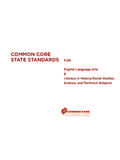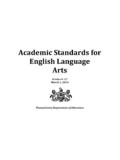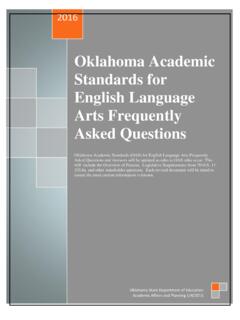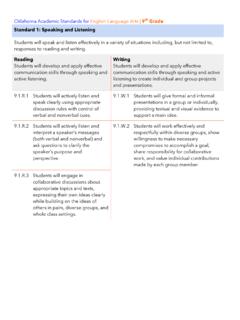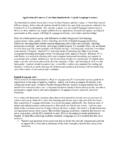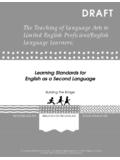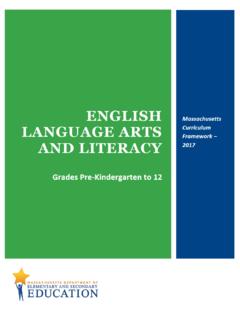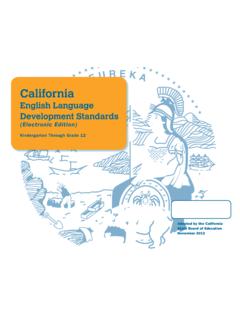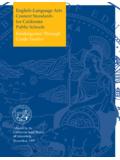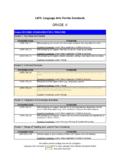Transcription of NJ English Language Proficiency Standards - ERIC
1 New JerseyEnglishLanguageProficiencyStandard s THENEWJERSEYENGLISHLANGUAGEPROFICIENCYST ANDARDS James E. McGreeveyGovernorWilliam L. Librera, of EducationRichard Ten EyckAssistant CommissionerEducational Programs and AssessmentJay DoolanDirectorAcademic and Professional StandardsIsaac R. BryantAssistant CommissionerDivision of Student ServicesJames F. CurryActing DirectorOffice of Specialized PopulationsMay 2004 PTM# 1504-493 Arnold G. Hyndman, President.. WarrenDebra Casha, Vice President.. MorrisMargaret F. Bartlett.. OceanRonald K. Butcher.. GloucesterMaud Dahme.. HunterdonKathleen A. Dietz.. SomersetAnne S. Dillman.. MiddlesexOrlando Edreira.. UnionJohn A. Griffith.. EssexThelma Napoleon-Smith.
2 MercerSamuel J. Podietz.. BurlingtonEdward M. Taylor.. CamdenRoberta Van Anda.. MonmouthWilliam L. Librera, , CommissionerSecretary, State Board of EducationSTATEBOARDOFEDUCATION4 5 ACKNOWLEDGEMENTSThe New Jersey State Department of Education gratefully acknowledges the dedicated efforts of the educators who served onthe committee that developed this Savarese-Muirhead,ConsultantThe George Washington University Center for Equity and Excellence in EducationArlington, VAAlicja Banning.. Clifton School DistrictSusanne Clark.. New Brunswick School DistrictKaren Crawley.. Manasquan School DistrictLiliana Habedank .. Clifton School DistrictPatricia Jasinski.. Absecon School DistrictElaine Kapusta.. Retired TeacherJacinta Kay.
3 Scotch Plains-Fanwood School DistrictPat Levine.. Colts Neck Regional School DistrictJudith O Loughlin.. Hohokus School DistrictEva Rogozinski.. Clifton School DistrictRogelio Suarez.. Elizabeth School DistrictNew Jersey State Department of Education TeamRaquel Sinai, Bilingual/ESL Education CoordinatorLori Ramella, Bilingual/ESL Education Program Development SpecialistMarcia Ashhurst-Whiting, , Language Arts/Literacy CoordinatorPatricia DeMarco-Rowe, Early Childhood SpecialistBarbara Gantwerk,Director, Office of Special EducationBrian Robinson, ,Director, Office of Evaluation and AssessmentA special thanks goes to Lauren Podolsky, Office of Specialized Populations special services employee and the BilingualAdvisory Committee.
4 TABLEOFCONTENTS6 State Board.. 4 Acknowledgements.. 5 Table of Contents .. 6 Introduction .. 7 Proficiency Levels .. 13 Pre-K-2 Listening.. 25 Pre-K-2 Speaking.. 27 Pre-K-2 Reading .. 29 Pre-K-2 Writing .. 33 Pre-K-2 Viewing and Media Literacy .. 353-5 Listening.. 373-5 Speaking.. 393-5 Reading .. 433-5 Writing .. 493-5 Viewing and Media Literacy .. 536-8 Listening.. 556-8 Speaking.. 576-8 Reading .. 616-8 Writing .. 656-8 Viewing and Media Literacy .. 719-12 Listening .. 759-12 Speaking.. 779-12 Reading.. 819-12 Writing .. 859-12 Viewing and Media Literacy.. 91 Bibliography .. 94 Background During the summer of 2003, the New Jersey Department of Education s Office of Specialized Populations, Bureau of Bilingualand English as a Second Language (ESL) Education revised the NJ ESL Standards in order to align them to the newly revisedNew Jersey Language Arts Literacy Core Curriculum Content Standards and to meet federal requirements of the No Child LeftBehind Act (NCLB).
5 The revised document, the New Jersey English Language Proficiency Standards , establishes a linkagebetween New Jersey s Core Curriculum Content Standards for Language arts literacy and five levels of English to this revision, New Jersey s ESL Standards stemmed from the ESL Standards for Pre-K-12 Studentsdeveloped by Teachersof English to Speakers of Other Languages (TESOL). The TESOL Standards are based on three broad goals for English languagelearners at all grade levels, which encompass the social, academic, and culturally appropriate uses of English . In order to helpdistricts to focus their ESL curriculum on the English Language competencies students must acquire in order to meaningfullyparticipate in content area classrooms, the newly revised document concentrates on Goal 2 of the TESOL Standards .
6 Goal 2 isto use English to achieve academically in all content areas. Goal 2 was selected as the overarching goal of the New JerseyDepartment of Education s English Language Proficiency III of the No Child Left Behind Actstates: Children who are limited English proficient [must] attain English Proficiency ,develop high levels of academic attainment in English , and meet the same challenging State academic content and studentacademic achievement Standards as all children are expected to meet. By linking the use of Language skills to the mastery of academic disciplines, the New Jersey English Language ProficiencyStandards establish the purpose of English Language teaching as that of enabling students to understand and use English foracademic purposes.
7 The relationship between Language arts literacy cumulative progress indicators and English languageproficiency levels demonstrates the point in the second Language acquisition process at which an English Language learner canmeet the Language arts literacy cumulative progress indicators associated with listening, speaking, reading, writing and viewingand media literacy Standards . Although the New Jersey Language Arts Literacy Standards begin with reading, the English Language Proficiency Standards arearranged in an order that reflects the Language acquisition process ( , listening, speaking, reading, writing, and viewing andmedia literacy). English Language Proficiency Standards are not different from Language arts literacy Standards .
8 However, thelanguage arts literacy Standards are based on an assumption that students are native speakers of English . Since Englishlanguage learners are not native speakers, it is pedagogically necessary to examine Language arts literacy Standards from theperspective of second Language acquisition stages or Language Proficiency levels, thereby facilitating the differentiation ofcurriculum and instruction to meet the needs of these students. 7 INTRODUCTION Purpose This document is intended to assist curriculum developers in the review and revision of ESL curricula to ensure alignment to theoverarching goal of teaching English Language learners to use English to achieve academically in all content areas.
9 Thus, anynewly developed or revised ESL curriculum should focus on integrating academic Language into the curriculum. Academiclanguage includes the following elements: lexical (vocabulary specialized and nonspecialized); syntactic (grammar); discourselevels (rhetoric); and functions (explain, describe, contrast, classify etc.)ProcessThis original alignment of New Jersey Language Arts literacy Standards and TESOL Standards was developed in 1999. This 2004curriculum alignment guide revision project was initiated by the Office of Specialized Populations, Bureau of Bilingual and ESLE ducation. The purpose of the project was to provide support for districts efforts to align their ESL curricula to the standardsand to ensure that ESL students are meeting the same academic Standards that all students are expected to meet.
10 A team of eleven bilingual and ESL teachers, representing diverse student populations and programs at the elementary, middle,and high school grades, met during the summer of 2003 to develop this document. A consultant from the George WashingtonUniversity, Center for Equity and Excellence in Education, Region III Comprehensive Center, provided initial guidance andongoing support. A Language arts literacy specialist from the New Jersey Department of Education s Office of Standards andAssessment also provided guidance to the project. Finally, a Bilingual/ESL education program specialist from the Office ofSpecialized Populations worked along with the team of teachers to develop the Standards , and edited and finalized thedocument for and Content of the English Language Proficiency StandardsThis document is organized around the goals and Standards of the New Jerseylanguage arts literacy Standards and Goal Twoof the ESL Standards for Pre-K-12 Students in grade clusters Pre-K-2, 3-5, 6-8, and overarching goal of the EnglishLanguage Proficiency Standards is that students acquire academic English (Goal two of the TESOL Standards ).










